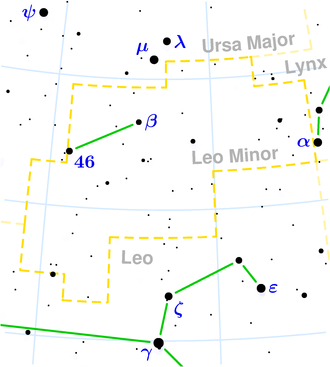NGC 3003
| Galaxy NGC 3003 |
|
|---|---|

|
|
| SDSS recording | |
| AladinLite | |
| Constellation | Little lion |
|
Position equinox : J2000.0 , epoch : J2000.0 |
|
| Right ascension | 09 h 48 m 36.0 s |
| declination | + 33 ° 25 ′ 17 ″ |
| Appearance | |
| Morphological type | SBbc |
| Brightness (visual) | 11.5 likes |
| Brightness (B-band) | 12.3 mag |
| Angular expansion | 5.7 ′ × 1.4 ′ |
| Position angle | 79 ° |
| Surface brightness | 13.6 mag / arcmin² |
| Physical data | |
| Affiliation | isolated trio |
| Redshift | 0.004930 ± 0.000003 |
| Radial velocity | 1478 ± 1 km / s |
|
Stroke distance v rad / H 0 |
(65 ± 5) x 10 6 ly (19.8 ± 1.4) Mpc |
| history | |
| discovery | William Herschel |
| Discovery date | December 7, 1785 |
| Catalog names | |
| NGC 3003 • UGC 5251 • PGC 28186 • CGCG 182-021 • MCG + 6-22-13 • IRAS 09456 + 3339 • KUG 0945 + 336 • 2MASX J09483604 + 3325173 • GC 1931 • H V 26 • h 639 • LDCE 676 NED003 • KTG 26A | |
NGC 3003 is a bar-spiral galaxy of the Hubble type SBbc in the constellation Little Leo in the northern sky . It is estimated to be 65 million light years from the Milky Way and about 30,000 light years across. Together with NGC 3021 and NGC 3067 , the isolated galaxy trio KTG 26 is formed .
In the same area of the sky are u. a. the galaxies NGC 3013 and IC 2508 .
The type IIL supernova SN 1961F was observed here.
The object was discovered by William Herschel on December 7, 1785 .
